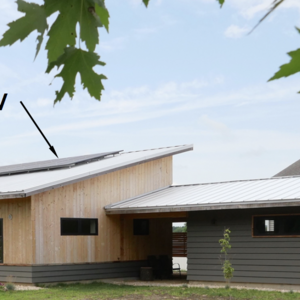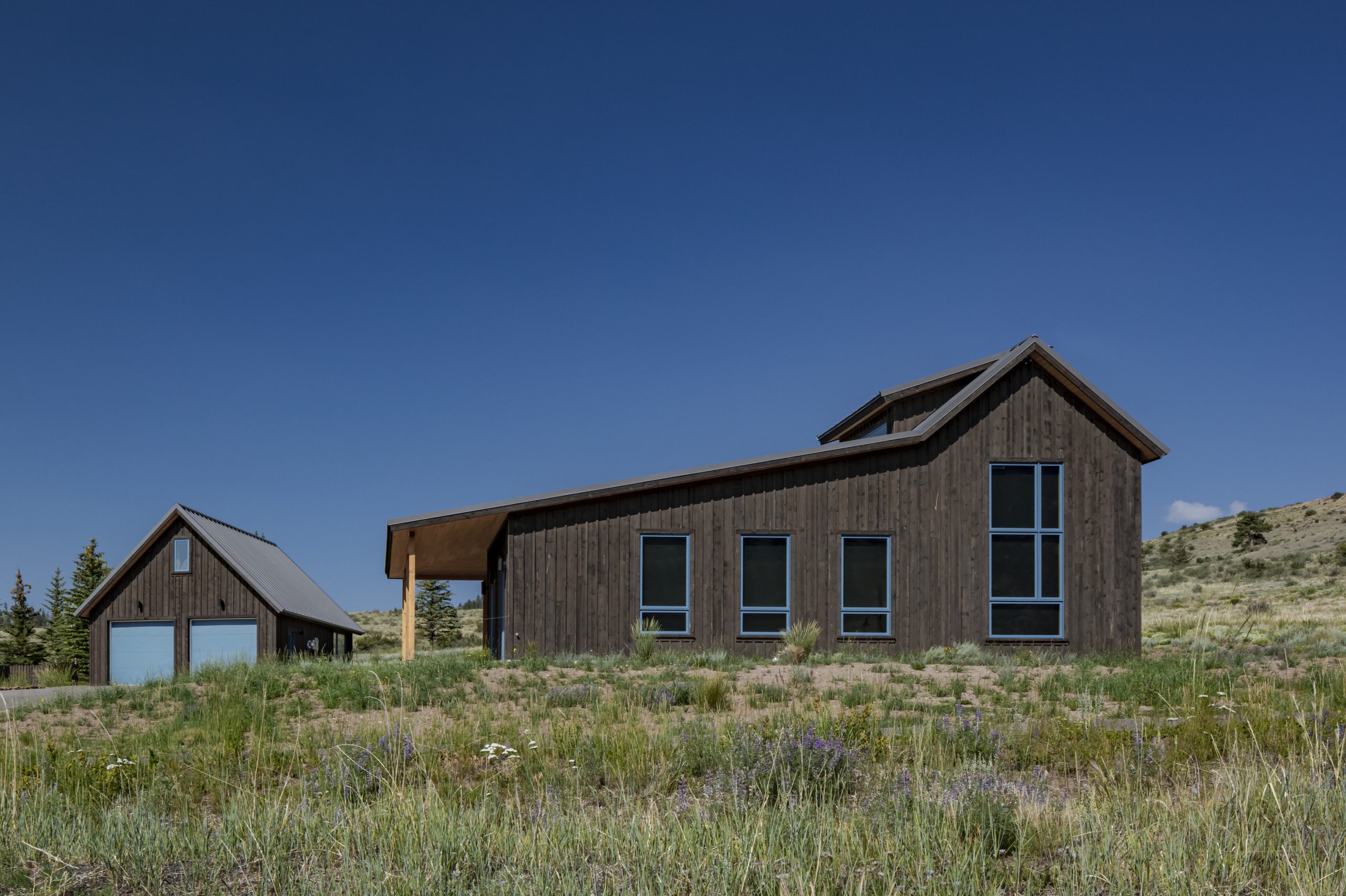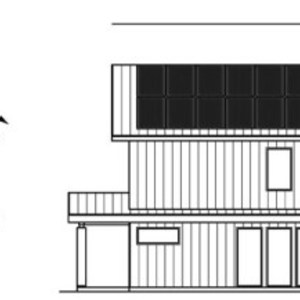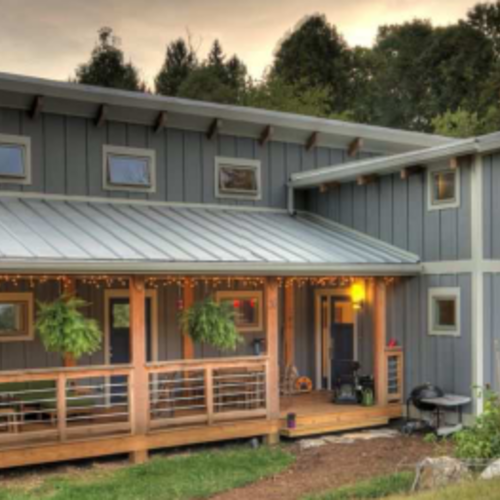
A quarterly survey by The American Institute of Architects shows rising interest in solar panels and docking stations for electric vehicles but declining interest over time in the number of people who say they want net-zero energy or superinsulated houses.
The findings for the third quarter of the year represent information that AIA member architects who design single-family homes gather in their dealings with clients. The survey, which measured changes in interest from 2018 to 2019, focused on a variety of home features. Other quarterly reports look at kitchens and baths, home and property design, and neighborhood and community design.
Many of the subject areas probably aren’t of particular interest to designers and builders who specialize in high-performance houses or sustainable design. But there are a few topics that relate directly to that type of construction.
As AIA Chief Economist Kermit Baker explained in a telephone call, the survey calculates the net difference between architects who report rising interest in a particular topic minus those who report declining interest.
Here’s what participating architects reported in the last survey:
- Interest in net zero and superinsulated houses is going down: In the most recent survey, the net interest level was about 23%, the same as it was last year. But the four-year trend is off sharply. In 2016, a net of 43.9% reported increased interest in net-zero building. That dropped to 31.1% in 2017. By way of contrast, there was twice as much interest in two other features—accommodations for multiple generations and ramps/elevators.
- Interest in electric car docking stations is going up: Interest was up slightly this year, growing from 57% in 2018 to 61% this year. In 2016, it was 47.7%, which rose to 54.1% the following year.
- Solar panels are gaining ground: Up from 41% last year to 52% this year. What’s just as interesting is the proportion of architects who reported that interest was declining—13% in 2018, down to just 6% this year.
- Energy management: Down slightly, from 63% a year ago to 62% this year.
Interest among prospective home buyers for technology friendly features—including extra outlet capacity and charging stations, wireless mobile charging docks, and USB wall outlets—dropped by five percentage points but remains strong at 64%.
The AIA has been conducting the surveys since 2005, Baker said, with the purpose being to learn “what’s hot and what’s not.”
In the area of solar panels and net-zero energy and superinsulated homes, Baker said trends could be partly explained by relatively low energy prices.
“Solar panels make a lot of sense if energy prices are high,” he said, “not that much if energy prices are low.” Ditto with net-zero construction, and interest could surge rapidly with a spike in energy prices.
Baker said the survey should not be viewed as a personal wish list from single-family architects.
“It’s not designed to be, ‘What do you think is going to be popular in five years, or what should be popular five years from now,’ ” he said. “It’s very much, ‘What are you seeing in your current practice and projects you’re working on.’ ”
What millennials don’t want
Over at realtor.com, another survey charts home upgrades that millennials say they don’t care about. There’s no mention of energy efficiency, air tightness, or indoor air quality either way. But we do learn that there are five things that actively repel potential homebuyers. They include:
- “Over-the-top” landscaping: Out with tidy, well fertilized lawns. Instead, millennials are said to prefer growing plants indoors and having an outdoor space that doesn’t require too much maintenance.
- Formal dining rooms. Let’s cook up a storm and eat in or near the kitchen.
- Rigid floor plans: Millennials would rather have open floor plans and rooms that can be used for a variety of functions.
- Brand new carpeting: Bare floors with “statement rugs” are more appealing and better for their pets.
- Memorabilia and game rooms: These are areas where you put a pool table or show off stuff you’ve accumulated, like golfing trophies. Millennials are more taken with digital things, so a big screen TV or media room is more likely to please, according to the report.
Realtor.com wasn’t specific on exactly when and how it gathered the information.
-Scott Gibson is a contributing writer at Green Building Advisor and Fine Homebuilding magazine.
Weekly Newsletter
Get building science and energy efficiency advice, plus special offers, in your inbox.















20 Comments
Basically they want to live in a home that they grew up in which is basically a PUD (attached/detached) where the HOA pays for lawn maintenance.
Why am I not surprised.
2% of vehicles sold in the US are electric and yet this "survey" says 60%+ want an electric vehicle docking station.....I'll take data that doesn't add up for $1,000, Alex.
It's entirely plausible that 95% of the EV's titled in the US are owned by people who live in a detached single family home or a townhome due to the charging convenience. Which means that it's entirely plausible that those who were surveyed primarily design detached single family homes or townhomes because these structures, detached single family especially, have the required design latitude for super insulation, solar, EV charging, etc.
Make sense?
If I had a two-car garage I'd seriously consider a EV because I could charge it regardless of the weather.
But why?
You might want to read the article. It says the survey indicated " interest in" docking stations, not that they want one. Why wouldn't someone be interested in one if contemplating a new house?
Stephen,
But Why has been commenting here sporadically for years. He is against all green or efficiency related initiatives. I have no idea why he bothers to visit or post on GBA when he disagrees with all of the content on the site.
“[Deleted]”
In a new house, a 50A, 240VAC circuit run to the garage makes sense to me. PV on the roof and super insulation - not so much (there are ways to be more green for less $).
I'm technically a millennial, and building a new house.
With regard to extra insulation/zero energy Vs solar. I think its possibly related to improvements in energy storage and lowering cost of solar. I could massively increase the building cost, adding more insulation, or could just add 7kw of solar to a tight, well built, relatively well insulated house and achieve "Zero Energy".
We're following the "Net Zero Energy Ready" guidelines, making sure the details are in place to add solar in the near future (not quite a day 2 project, but close).
Its shortsighted to not include the base infrastructure (space for a 50A 240VAC circuit) for a EV charging station. Electric vehicles will only become more common, I added a charger for our Leaf, it was easy and cheap (but I did it myself)
I did the design myself, goal being low maintenance, inexpensive construction details and decent energy efficiency. Previous houses of mine had large yards, and lots of trees to maintain. Personally I'd rather spend my free time doing something I enjoy, not yard work. No lawn, steel roof, steel siding, concrete patio, all mean more time I can do what I want and have the additional benefit of wildfire resistance. 1300sqft, 2bd, 1ba, concrete floors, big open space are all based on how we use our space. I agree with the "Memorabilia/Game room" not being significant, but not the reasoning behind it.
Photo is progress as of last night. Bonus points to anyone who knows what rock that is.
> more insulation, or could just add 7kw of solar
Or maybe you could take the same money and do more for the environment by doing something that isn't related to your building.
Like the oil crunch in the 1970's. It took high gas prices & shortages to finally sway people to drive more efficient gasoline powered vehicles. Getting 10mpg was no longer acceptable and desirable as nobody wanted to pay that much $$ for expensive fuel. Once gas prices dropped in the 80's and 90's, then came the SUV gas guzzlers. Once gas prices increased again, the gas guzzling SUVs became unwanted.
The same plays true for homes. When the avg cost of electricity is just 12 cents per kWh and natural gas is relatively inexpensive. Who cares if your home is inefficient and hogs energy? Electricity is so cheap, just turn up the AC in summer and crank the heat in winter.
Not until prices climb, calamities hit (loss of power, natural disasters), will people look for energy efficient homes. That is the nature of the beast and the human condition. If it's cheap, people will waste it and not care. In countries like Germany, where electricity is closing in at 50 cents per kWh. People think twice about how energy efficient ones home is. Plus Germany has way stricter building codes and is mandating Passive House design for all new homes.
The low (and still falling) levelized cost of wind and solar is putting downward pressure on wholesale electricity pricies. Any impending price spike in electricity will have to happen when commodity fuels such as natural gas or uranium are still a large fraction of the mix. In the intermediate term that can still happen, but in the long term (over the lifecycle of a house) the risk should be fading.
That's not to say one should go ahead and build large inefficient energy hog houses, but only to point out that the energy price risk hedge argument isn't super compelling now, and will be even less compelling as the energy transition rolls out.
And yet the solar install companies I contacted for quotes all assume in their proposals that electricity prices will steadily go up. If you discount this position the economic case for these installations are not as compelling. Allowing homeowners to buy into large community solar projects seems to make more sense. NJ has instituted this but it is hard t o find out how to get involved.
We will be making excuses on why it makes no sense to conserve energy while the seas rise and overtake us. Airtight, energy efficient construction and retrofit is not that tough, can't be done lying on the couch though.
Never conflate "energy use" with "dirty energy use".
First, this survey is of architects, who are only designing for the top 1-5% of housing. Hardly an indicator of typical industry perspective. This is an indicator of just the wealthiest little tip of the pyramid.
Second, the headline is confusing because it only mentions Net Zero, but then the first paragraph adds "or superinsulated". In fact, the survey page "Special Features" lists only 5 features above Net zero/super-insulated... AND THEY ARE ALL ABOUT ACCESSIBILITY. Clearly, the market is focused on those aging, wealthy Boomers. I think it is impressive that energy is even on the list from people who are not expecting to live longer than their home's first maintenance cycle.
Thirdly, I feel Net Zero has always been a tough sell because active PV systems require continuing maintenance and replacement. Better insulation is passive, boring, and doesn't give you the sense of participating in technology. PV is bling on your roof, the status symbol that tells everyone else you care more than they do. Except that the payback doesn't, and you end up with a continually depreciating technology that needs to be replaced to keep up with the Jones. I'm not saying that active systems can't help, but a great envelope is a multi-generational reduction of consumption. #longliveourbuildings
Steve Hall- while I agree that a great building envelope is essential, pv systems don't require much maintenance at all. Mine is four years old and hasn't needed any maintenance whatsoever.
Was it a good investment? Cost before the federal tax credit of about $6300 ( no state incentives here in Maine) was about $21k for a 6.6 kw system. It produces an average of around 8,000 kwh per year. Electricity prices have steadily risen from about 15¢ to about 19¢. So right now, my system generates a about $1500 per year in electricity. I think that's a decent return on investment.
As for power prices, while gas may or may not stay cheap, cost of building and maintaining the grid will probably rise. Maine electric rates are about half power cost and half transmission/ distribution. At an average wholesale cost of electricity of less than 3¢, we're paying around 9¢ retail for the power portion. About half of the electricity sold in New England is generated by natural gas.
Stephen Sheehy — Thanks for these data points. Do you mind if I ask what your tax credit was worth?
My logic is that the total investment for an active system is equal to or exceeds a passive, insulating one. But passive systems require nothing further for the life of the building, whereas a PV system is going to fail eventually. Hopefully not within 4 years, but inevitably. Will the tax credit be available to replace it? Other than the copper wiring, the panels and controllers will all be totally new.
I view PV just like an HVAC system. It's great that the government will buy parts of it for us, but if we would build houses that need very little tempering, the embodied energy in buying and installing the system wouldn't be required in the first place.
Steve Hall- Sorry, but I misstated the cost. It was $21k before federal credit of about $6300, so our out of pocket cost was about $15k. I'll edit my comment to correct that.
My house is tight, .59ach50. Very well insulated, R 20 under slab, R 42 double stud walls, R70 above ceiling. Triple pane windows. About 1650 square feet of conditioned space.
So I agree with your comments that encourage construction of a small, robust and efficient envelope. But pv is also a pretty passive system, expected to generate electricity with little or no maintenance for 30 years or more. Panels have no moving parts.
Since almost all of us need electricity and a source of heat, it made sense to use pv to produce most of the electricity needed to run the house. In a cold climate like mine, zone 6, it would not be sensible or cost effective to go without any source of heat or to go without electricity. Given that, putting pv on the roof was a reasonable choice. Obviously, with a good envelope, we didn't need a big heating system. Two ductless minisplits do the job. In retrospect, we probably could have managed with one minisplit.
Go with Perfect Solar Home to go green in less $
http://www.perfectsolarhome.com/
You have Greta Thunberg giving her speech to the UN and then you have this study that buyer interest in energy efficient homes in the USA is lagging.
So which is it? Do people want more efficient homes that reduce the loads on the environment or is it all just theatrics and hot air?
Log in or create an account to post a comment.
Sign up Log in